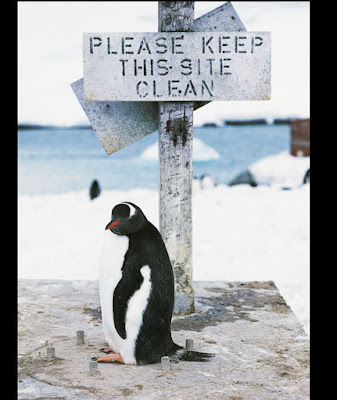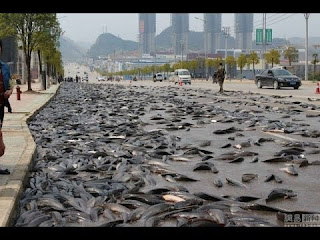We have already written extensively about the tragic
consequences of over 2,000 nuclear bombs detonated around the Earth during the
Cold War, with seventy-five percent underground.
Named “Little Boys,” the two bombs that hit Japan in 1945
were 15 and 21 kilotons. Far more
powerful nuclear bombs detonated more recently.
From a mathematical standpoint, the difference is startling.
In metric terms a ton is 1,000 kilograms. Nuclear weapons tests have ranged from the
early kilotons to a fifty-megaton bomb by the USSR. So, a kiloton is then 1,000 tons and a megaton 1,000,000
tons. Thus, a megaton is larger by a factor of 1000.
Consider
this, that USSR monster has a force of 50 megatons, which is equivalent to 3,333 Little
Boys or 50 million US tons of TNT. So
powerful is the bomb that if one dropped on Washington DC, the blast zone would
extend all the way to Baltimore, 41 miles.
It
is not out of the question that the 2000+ nuclear explosions could have a
combined impact of nearly one million megatons.
What have we done to our Earth? Our
man made toxic poisoning of the Earth is now being processed by the Earth, with
no help from the people.
Thank
goodness our Creator made plans for our mistakes and created a purification
mechanism to preserve the Earth. While
my other articles address this issue in detail, rest assured the Earth, through
natural processes, is purifying the toxic mess.
Gravity draws the radioactive and super-heated nuclear debris
to the core of there Earth where 11,000 degree magnum exists, somewhat similar
to the temperature of the surface of the Sun.
Here is the temperature of nuclear explosions according to
scientific experts.
"Fusion reactions
require that the atoms be raised to temperatures of millions of degrees."
Zitzewitz,
Paul & Robert Neff. Physics. New York: Glencoe, 1995.
-------------------------
"… temperature of millions of degrees Celsius"
Taffel,
Alexander. Physics: It’s Methods and Meanings. Englewood Cliffs, NJ: Prentice Hall, 1992.
-------------------------
"… fireball whose temperature is over 10 million
degrees"
Rammanohav, Reddy C. Effects of a Nuclear Bomb Attack. Kathmandu, Nepal: Himal, 1998.
"Within 17 meters, the explosion temperature was
300,000 degrees Celsius. Within 50 meters it was 9,000-11,000
degrees, and at ground level beneath hypocenter the temperature exceeded 6,000
degrees."
Soo,
Jason. Atomic Education, Enscquire, 7, 4 (September 1995): 10.
-------------------------
"… instantaneously reached several million degrees
centigrade"
Ochi,
Yukiko. Nagasaki marks 53rd
anniversary of atomic bombing. Internews, 1998.
When super-heated radioactive debris gets to the core of the
Earth the natural reaction is to absorb it into the core and expel it through
the vast network of fissures created for Earth including volcanoes,
earthquakes, geysers, hot springs, or other natural outlets.
We have reached the height of the absorption with toxic
waste expelled through every nook and cranny and the resulting release of the
pressure and heat build up within our Earth demonstrating the power of Earth to
self-heal.
Just remember that this period of extensive heat buildup is
temporary and not part of the natural cycle of an Ice Age to warming. Our last Ice Age was 11,000 years ago meaning
the pendulum spans close to 14,000 years each direction.
Yet
another unintended consequence!
Beyond the purification of the earth underway there is
another unintended consequence missed by science. Many long dormant volcanoes have erupted to
help with the purification and we are just discovering that hundreds of them
could lie directly under the polar ice caps.
New research techniques used helped detect over 90
volcanoes erupting far under the Antarctica Ice Cap, in a very small section of
the Ice Cap. There could be hundreds of
them under the massive ice caps all pouring the super heat up underneath the
ice.
This very unnatural action could melt the ice caps much
faster from below than the carbon impact from above the earth. It would drastically distort normal climate
change or global warming.
Hiding beneath the massive Antarctic Ice Sheet lies one of the
densest clusters of volcanoes in the world. A recent study discovered 91 new
volcanoes, adding to the 47 already identified volcanoes.
What is troubling scientists is the ability for these volcanoes,
if they erupted, to cause wide scale melting and breakup of Antarctica's ice
sheets. The research was conducted by a group of geologists at the University
of Edinburgh and recently published in a special publication of the Geological Society of London.
Volcano climate SHOCK: Heat source under
Antarctica could be melting giant ice caps
Nature Communications published the report.
According to NASA, satellite data collected since 2002 shows
both the Antarctic and Greenland ice sheets have been losing mass.
The agency further stressed the melting ice has accelerated
since 2009.
Further satellite observations show the average global sea level
has risen by nearly seven inches in the past 100 years.
Ironically, the effects of climate change are not very
predictable, especially since we still do not understand the contributing factors.
In 2007 former
US Vice-President Al Gore gave an apocalyptic speech. 'The North Polar ice cap
is falling off a cliff,' he said. 'It could be completely gone in summer in as
little as seven years. Seven years from now.'
Those comments came in 2007 as ex-VP Gore accepted the Nobel Peace Prize
for his campaigning on climate change.
But seven years after his warning, The
Mail on Sunday Newspaper revealed that, far from vanishing, the Arctic ice cap
had expanded
for the second year in succession - with a surge,
depending on how you measure it, of between 43 and 63 per cent
since 2012.
To put it another way, an area the size of Alaska, America's biggest state, was open water two years ago, but is again now covered by ice.
Recent US Navy technology has identified
substantial heat generated by volcanoes far under the ice caps and it could
well be the eruptions are the real cause of global warming.
People are still the cause of what is
happening, only is may be the sins of the father rather than our sins driving
global warming. We have much to learn
about the impact of the vast radiation poisoning of the earth and the natural
purification underway.
It also means the current climate change
may accelerate from the radiation purification, but it will stop soon enough as
the remainder of the radiation expels.
Does that mean natural climate change will take over again?
If so, then the Creator has done a far
greater job of anticipating the needs of Creation than we might expect and we
still have time to make our contribution to the preservation of the earth for
future generations.

























































